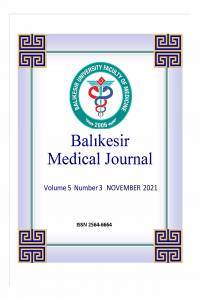Olgu Sunumu
Yıl 2021,
Cilt: 5 Sayı: 3, 119 - 123, 30.11.2021
Öz
Blue toe syndrome is a clinical condition characterized by pain and cyanosis in one or more toesor soles of the feet due to microvascular occlusion. The most common cause is atheroembolicdisease or aneurysm. Embolization occurs typically from an ulcerated atherosclerotic plaqueor aneurysm located in the aorto-iliac artery and femoral arteries. Dianosing and treating thesource of embolism in a patient with blue toe syndrome is very important in order to preventrecurrent embolism that may result in limb loss and / or death. On the other hand, palpableperipheral pulses in the first physical examination performed on a patient presenting with theabove-mentioned clinical symptoms excludes vascular pathologies, which may lead to delayin diagnosis. Suspecting microvascular occlusion and using imaging methods to diagnoseintravascular pathologies are quite important in these patients. In our case, there was painand blue / purple discoloration on the soles of both feet, which was aggravated by walking.Peripheral pulses were palpable on physical examination. When CT angiography images andbiopsy results from existing lesions were evaluated in the light of clinical findings, a diagnosis ofblue toe syndrome was made.
Anahtar Kelimeler
Kaynakça
- Applebaum RM, Kronzon I, Evaluation and management of cholesterol embolization and the blue toe syndrome, Curr Opin Cardiol,1996:11;533-542, DOI: 10.1097/00001573-199609000-00013
- O’Keeffe ST, Woods BO, Breslin DJ, Tsapatsaris NP, Blue toe syndrome: causes and management, Arch Intern Med,1992:152;2197–2202, DOI: 10.1001/archinte.1992.00400230023004
- Caldwell BD, Marrochello VS, Microembolization from atheroembolic disease or aneurysm. A case study, J Am Podiatr Med Assoc,1996:86;249-52, DOI: 10.7547/87507315-86-6-249
- Blackshear JL, Oldenburg WA, Cohen MD, Making the diagnosis when the patient has ‘blue toes’, Geriatrics,1994:49;37-39, 43-45
- Oweis Y, Viets Z, Shetty AS, Role of lower extremity run-off CT angiography in the evaluation of acute vascular disease, Abdom Radiol,2017:42;1028–1045, DOI: 10.1007/s00261-016-0907-4
- Aboud AA, Abrams M, Mancini AJ, Blue toes after stimulant therapy for pediatric attention deficit hyperactivity disorder, J Am Acad Dermatol,2011:64;1218–1219, DOI: 10.1016/j.jaad.2009.11.010
- Brown PJ, Zirwas MJ, English JC, The purple digit: an algorithmic approach to diagnosis, Am J Clin Dermatol,2010:11;103–116, DOI: 10.2165/11530180-000000000-00000
- Hirschmann JV, Raugi GJ, Blue (or purple) toe syndrome, J Am Acad Dermatol,2009:60;1–20, DOI: 10.1016/j. jaad.2008.09.038
- Vayssairat M, Chakkour K, Gouny P, Nussaume O, Atheromatous embolisms and cholesterol embolisms: medical treatment, J Mal Vasc,1996:21;97-99
Yıl 2021,
Cilt: 5 Sayı: 3, 119 - 123, 30.11.2021
Öz
Blue toe sendromu; mikrovasküler oklüzyona bağlı bir veya daha fazla ayak parmağında veya ayak tabanında ağrı ve siyanoz ile karakterize klinik durumdur. En sık nedeni ateroembolik hastalıklar veya anevrizmadır. Embolizasyon genellikle aorto-iliak, femoral arterlerde bulunan ülsere aterosklerotik plaktan veya anevrizmadan meydana gelir. Blue toe sendromu gelişen bir hastada emboli kaynağını tespit ve tedavi etmek, uzuv kaybı ve/veya ölüm ile sonuçlanabilecek tekrarlayan embolileri önlemek adına oldukça önemlidir. Bununla birlikte yukarıda belirtilen klinik semptomlarla başvuran hastada yapılan ilk fizik muayenede periferik nabızların palpabl olması klinisyenleri vasküler patolojilerden uzaklaştırmakta, buna bağlı tanı koymada gecikme söz konusu olabilmektedir. Bu hastalarda mikrovasküler oklüzyondan şüphelenilmesi ve damar içi patolojileri teşhis için görüntüleme yöntemlerine başvurulması hayati önem arz etmektedir.
Anahtar Kelimeler
mavi ayak baş parmağı sendromu ateroembolizm mikrovasküler oklüzyon
Kaynakça
- Applebaum RM, Kronzon I, Evaluation and management of cholesterol embolization and the blue toe syndrome, Curr Opin Cardiol,1996:11;533-542, DOI: 10.1097/00001573-199609000-00013
- O’Keeffe ST, Woods BO, Breslin DJ, Tsapatsaris NP, Blue toe syndrome: causes and management, Arch Intern Med,1992:152;2197–2202, DOI: 10.1001/archinte.1992.00400230023004
- Caldwell BD, Marrochello VS, Microembolization from atheroembolic disease or aneurysm. A case study, J Am Podiatr Med Assoc,1996:86;249-52, DOI: 10.7547/87507315-86-6-249
- Blackshear JL, Oldenburg WA, Cohen MD, Making the diagnosis when the patient has ‘blue toes’, Geriatrics,1994:49;37-39, 43-45
- Oweis Y, Viets Z, Shetty AS, Role of lower extremity run-off CT angiography in the evaluation of acute vascular disease, Abdom Radiol,2017:42;1028–1045, DOI: 10.1007/s00261-016-0907-4
- Aboud AA, Abrams M, Mancini AJ, Blue toes after stimulant therapy for pediatric attention deficit hyperactivity disorder, J Am Acad Dermatol,2011:64;1218–1219, DOI: 10.1016/j.jaad.2009.11.010
- Brown PJ, Zirwas MJ, English JC, The purple digit: an algorithmic approach to diagnosis, Am J Clin Dermatol,2010:11;103–116, DOI: 10.2165/11530180-000000000-00000
- Hirschmann JV, Raugi GJ, Blue (or purple) toe syndrome, J Am Acad Dermatol,2009:60;1–20, DOI: 10.1016/j. jaad.2008.09.038
- Vayssairat M, Chakkour K, Gouny P, Nussaume O, Atheromatous embolisms and cholesterol embolisms: medical treatment, J Mal Vasc,1996:21;97-99
Toplam 9 adet kaynakça vardır.
Ayrıntılar
| Birincil Dil | Türkçe |
|---|---|
| Konular | Klinik Tıp Bilimleri |
| Bölüm | OLGU SUNUMU |
| Yazarlar | |
| Yayımlanma Tarihi | 30 Kasım 2021 |
| Yayımlandığı Sayı | Yıl 2021 Cilt: 5 Sayı: 3 |

Bu eser Creative Commons Alıntı-GayriTicari-Türetilemez 4.0 Uluslararası Lisansı ile lisanslanmıştır.


